Alston Lane
Alston Lane is accessed from either end by a main road. On foot this can present a daunting challenge if you're heading that way during the rush hour. The best bet is to set out early in the morning.
With that in mind it's often the case that you can often follow the advice of others to the letter but unintentionally ignore your own. We had our hearts set on Alston Lane that day. The later start left us feeling undeterred. Once across the road, the steady stream of traffic was soon left behind. Walking along the recently resurfaced road, the noise soon ebbed away and you enter a world of farmhouses and barn conversions. In the hedges we spied a caterpillar crawling and seemingly munching on the seed-heads of hogweed.
We followed the flat stretch of Alston Lane, negotiated a couple of corners and then turned off before Higher Alston. We were heading up a short stretch of the John Musgrave Heritage Trail.
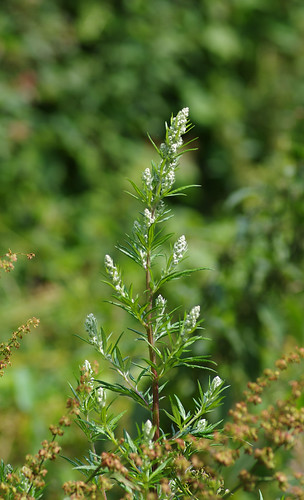
Mugwort (Artemisia vulgaris)
I have seen this plant regularly in the last few weeks. It has dark, glossy green, pointed leaves and light, knobbly flower heads. From this angle it looks relatively ordinary.

But it's not often you see hogweed (capable of growing above my head) made to look so insignificant. I reckon it's been over a year since we last walked along and up this path. At the corner, the stream has been banked up with mud (presumably to prevent flooding.) The path runs parallel to the stream at first. At head height, the air was drowsy with the buzz of bees. Above our heads, the sweet song of larks wafted down and it was very tempting to stand and do nothing; absorbing the sights and sounds.
But there was work to be done and hedgerows to scan.

Hybrid Woundwort (Stachys x ambigua)
This flower is very similar to Hedge Woundwort. The flowers are pale pink as opposed to dark pink. You can just make out the sticky-looking hairs on the stem, whereas Hedge Woundworts can appear downy. The leaves of the above also provided a clue. They are elongated as opposed to rounded.

White Clover (Trifolium repens)
I really like the bracken background here. And although the stem is a bit too soft (as if floating) I could not stop wondering: what was it about this habitat that seemed to produce such gigantic specimens?

Hemp Agrimony (Eupatorium cannabinum)
We saw budding Hemp Agrimonies at Berry Head the other week. In flower, they appear even more impressive. There were a lot of them, too, bunched together by the side of the stream.
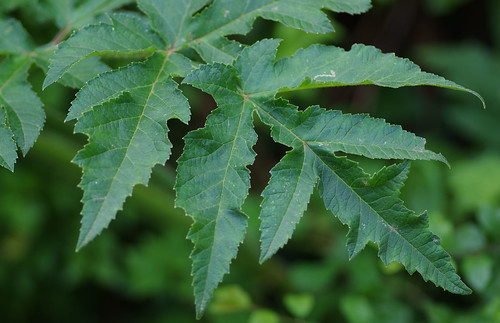
Hogweed leaves (Heracleum sphondilium)
I let my hopes run away with me when I saw these leaves. Usually hogweed leaves are curled up. I even convinced myself that I had seen the leaves of the Giant Hogweed. Both plants are poisonous to humans and should be left well alone. Further up the lane, there were other camera-shy flowers, including Enchanter's-nightshade and a grass head playing host to a tiny grubby caterpillar.
Then a man coming down the lane gave us a welcome tip-off: he had just seen a Golden-ringed Dragonfly at the top, hunting and eating prey. We passed several other points of interest which diverted our attention. By the time we got to roughly where the man had directed us, I don't think we expected to see anything. And then suddenly there it was: clinging to a grass stem. Sherry approached warily and began snapping away and edging closer still...
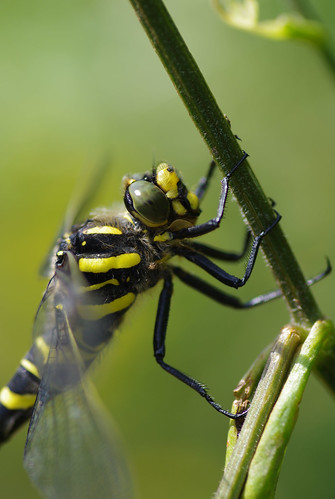
Golden-ringed Dragonfly (Cordulegaster boltonii)
The blurriness of the wings suggest a sense of movement as if the creature above had just landed. But in truth it had been there for some time. Up close, dragonflies often appear to be smiling and this one proved no exception. We would subsequently find out that behind that smile were some very powerful jaws.
At the top of the lane, we walked left along the side of the main road and then crossed over. Beyond a stile, a permissive path led alongside a meadow. There was a wild verge with many different species to record and photograph.
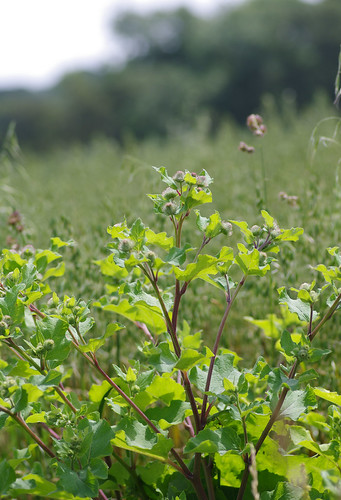
Lesser Burdock (Arctium minus)
We glimpsed a day-flying moth frenziedly dashing between the hedgerow and the field (to feed on the white pollen of hogweed) and back. But it was too quick for either of us. Instead, we decided to sit down, unwind and enjoy lunch. Sometimes, by resting for a few minutes, the wildlife comes to you. And lying down, I was better able to apprecaite the lower, diminutive plant species: fumitories blushing pink, yellow Field Pansies and the not-so-elusive Scarlet Pimpernels. Flowers classed as arable weeds that are unable to thrive in an intensively farmed field.
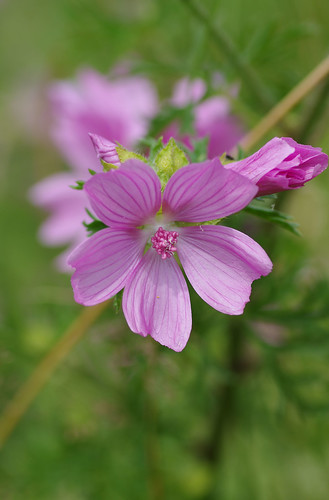
Musk-mallow (Malva moschata)
We encountered red beetles mating, other unfamiliar bugs on grass stems and the odd Small-White butterfly into the bargain.
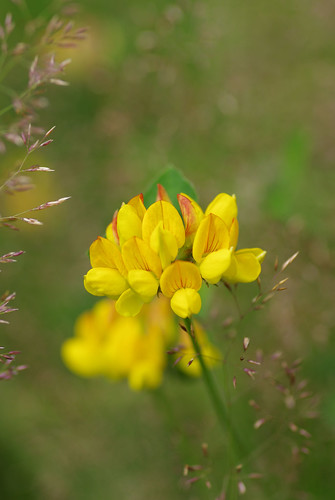
Common Bird's-foot Trefoil (Lotus corniculatus)
This was dreamily rendered among the feathery grasses.
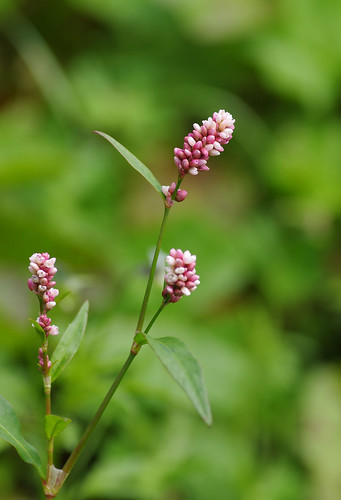
Redshank (Persicaria maculosa)
And this was the best Redshank shot.
At this point we should have pressed on and down to Lupton House and round, to close the circuit, so to speak. But instead we turned back, hoping for a better glimpse of our hyperactive moth friend.
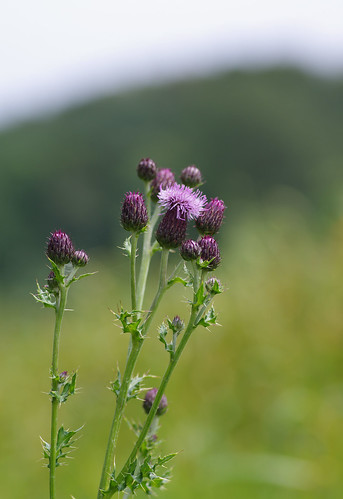
Creeping Thistle (Cirsium arvense)
I'm certainly glad we turned back when we did. Although the moth was still too quick, Sherry did manage to grab this shot just in time before it gave us the slip and disappeared.

Large Yellow Underwing (Noctua pronuba)
Underwings are members of the Dart family of moths. This one certainly lived up to the name: darting about everywhere. We did not have chance to see under its wings but this is a common species and often seen at this time of year. The Latin name is somewhat misleading because noctua made me think of night and this moth was resolutely not the nocturnal type.

Spear Thistle (Cirsium vulgare)
We have seen these thistles ample times before but never quite like this. For some reason the texture of the flowers made me think of dessicated coconut. And this was after lunch!
Once over the stile, we crossed the road and briefly wandered along the lane to the left. In spite of the sign, there has often been evidence of fly-tipping in the past. Thankfully, today there were no piles of garden rubbish or dumped domestic appliances.

Crab Spider on Scabious flower
As well as being formidable hunters, these spiders are veritable chameleons. The females can change fron white to yellow and sometimes light green during the course of their lifetime.
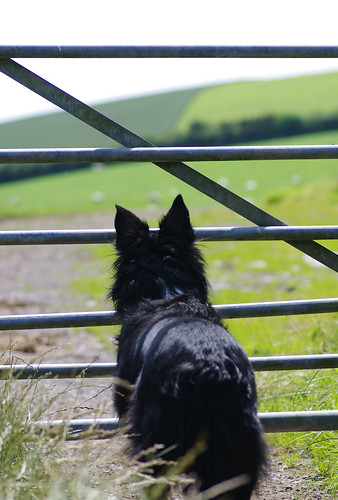
Counting sheep before bedtime
Sherry took several close-up portraits of Lady, panting, sitting and posing for the camera. My favourite is this more unconventional shot. When she began photographing the dog's back I initially thought she had been in the sun too long. I was a bit slow on the uptake, and did not really see the point, engaged as I was with identifying the feverfew flowers below.
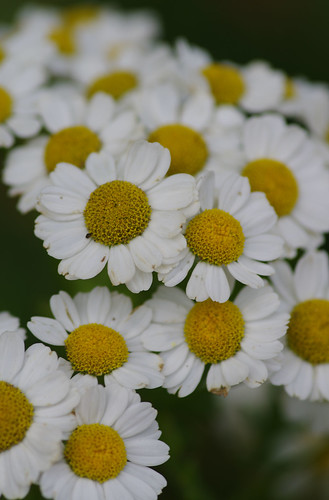
Feverfew (Tanacetum parthenium)
This is a warts-and-all shot. I could have spent hours post-processing to make the flowers whiter than white. But in my book that would have been cheating. These flowers may have been past their best but it should be our aim to record what we see as faithfully as possible even when the results are not particularly aesthetically pleasing.
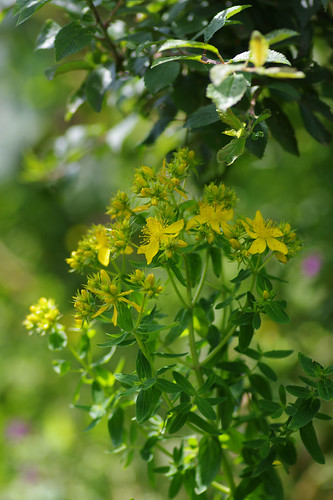
Perforate St John's-wort (Hypericum perforatum)
I did spend longer than intended trying to identify this species. Pulled up under the magnifier, there were the tiniest of black dots on the edge of the petals and perforations in the leaves (hence the name perforated.)
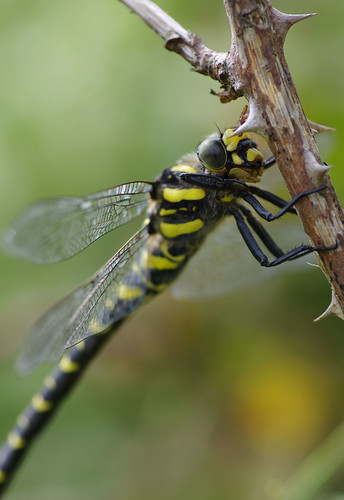
Near the top of the same lane on our return journey, we came across another Golden-ringed Dragonfly. Sherry got close enough to hear it crunching its lunch. If you look closely you might be able to see a pair of legs in its mouth. I have seen this species of dragonfly in Loddiswell and on the edge of Dartmoor but never so close to home.
As luck would have it, when going down the lane we saw the man who had given us the initial tip. He explained he was from Cumbria and was staying with friends nearby. He clearly knew his way around a flower guide, too - helping me identify some hedge bedstraws that I was puzzling over. There were a number of flowers present locally that could not be seen in his native Cumbria, and vice versa.
I hope that we will soon get to explore different areas of the country and expand our range. But for now we are still mining the depths of our local patch and finding something new with every walk. It makes me wonder at the sheer level of diversity around us. Whatever the habitat, there is always something somewhere, waiting to be discovered.
To follow this route or invent an alternative, you will need OS MAP OL20 SOUTH DEVON.
The map does not show the permissive path for Lupton House but if you walk a hundred metres or so along the grassy verge by the side of the A379 towards Kingswear you should see a stile. You can follow the path to Lupton and then back to the Brixham Road (a better place to cross.) Turn left along this road and then right along Churston Road. This road will lead you through Churston Village. And if you've built up a thirst, just past the tennis club there is a turning on the left leading to the Churston Court.

Comments
Add a Comment